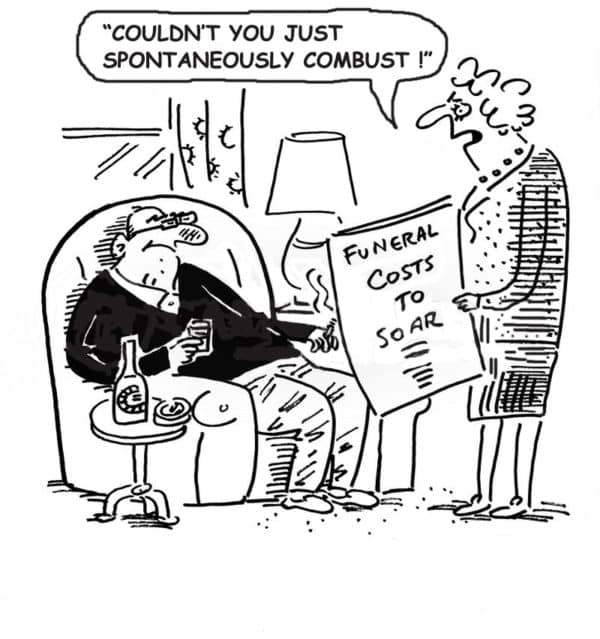How the first caveman’s eyes must have glowed when he discovered fire. It has mesmerised humans ever since. It must have paved the way — this was during the Early Stone Age — for the first barbecue, the first burnt sausages, the first singed eyebrows.
People themselves have sometimes burst into flames for no apparent reason, self-igniting like the Harpo Marx candle that burned at both ends in the film Horse Feathers. One of the earliest examples of this spontaneous combustion was the Italian countess Cornelia Bandi, who used to sprinkle brandy on herself to relieve physical pain, I wonder if that’s a clue? Personally, I prefer the more traditional method involving a glass and some sugared almonds, which originated in Italy like the lady herself.
I believe we can dismiss the theory propounded in the book Fire from Heaven that spontaneous combustion is connected to poltergeist activity. And as for the fate of Mr Krook, an alcoholic rag dealer in Bleak House, well, Charles Dickens has often been accused of making things up.
Recorded cases were often heavy drinkers and elderly females, and past investigations frequently pointed to means of ignition (not car keys, obviously) located near the victims. Candles, lamps, chair stuffing and fireplaces were in close proximity to the deceased, so most of us are safe enough in this day and age, unless we still use coal fires or sit too long in armchairs.
If ‘spontaneous’ combustion exists, why don’t we see it more in everyday life? Citizens bursting into flames while walking their dog, or sitting in the cinema watching The Towering Inferno, or standing in a queue outside a bank? Although the last-mentioned might become incandescent when refused an overdraft.
Self-immolation, as seen memorably in one Wallander episode, is a form of suicide, an extreme type of political protest, or the result of unrequited love. “I’m just a hunk of burning love,” sang Elvis in Hawaii, where the sun is a source of burning pavements.
Lots of people were famous either before or after they burned to death. Joan of Arc, burned at the stake aged just 19 in 1431, after her own side betrayed her to the English, was accused among other things of wearing men’s clothes when she had been warned not to. Fashions have changed a lot in France since then.
Archbishops of Canterbury, Knights Templar, Norwegian witches — religion and superstition were on numerous occasions what caused persecutors to reach for the matches. The actress Linda Darnell died in a house fire when she refused to jump from the window of a burning building because she suffered from vertigo. A dizzy blonde whose film Star Dust was showing on TV later that same evening. Let’s not even speculate about the last moments of Buddy Holly and The Big Bopper the day the music died.
I just heard on the news that the coronavirus is “heating up again.” Let’s hope it spontaneously combusts, immolates, disintegrates or otherwise self-destructs when it sees a vaccine-filled needle approaching, ready to… “Fire!”







This article claims that Joan of Arc was betrayed by her own side, which has been debunked by historians: it’s based on the misconception that Charles VII could have “bid for her life” at “auction” although there was no auction (she was transferred from the Burgundian faction to their English allies as a result of a private deal between them). 15th century sources say Charles VII tried to ransom her but the Burgundians refused. The article also says she was accused of “wearing men’s clothes”, which is misleading since the “men’s clothes” were just the soldiers riding outfit and other clothing that had been given to her to wear in the army. The pro-English tribunal couldn’t find any other excuse to convict her, according to dozens of eyewitnesses who had taken part in the trial: e.g., the bailiff, Jehan Massieu, later said that the guards manipulated her into a “relapse” by taking away her dress and forcing her to put the soldier’s clothing back on, then the judge condemned her to death.